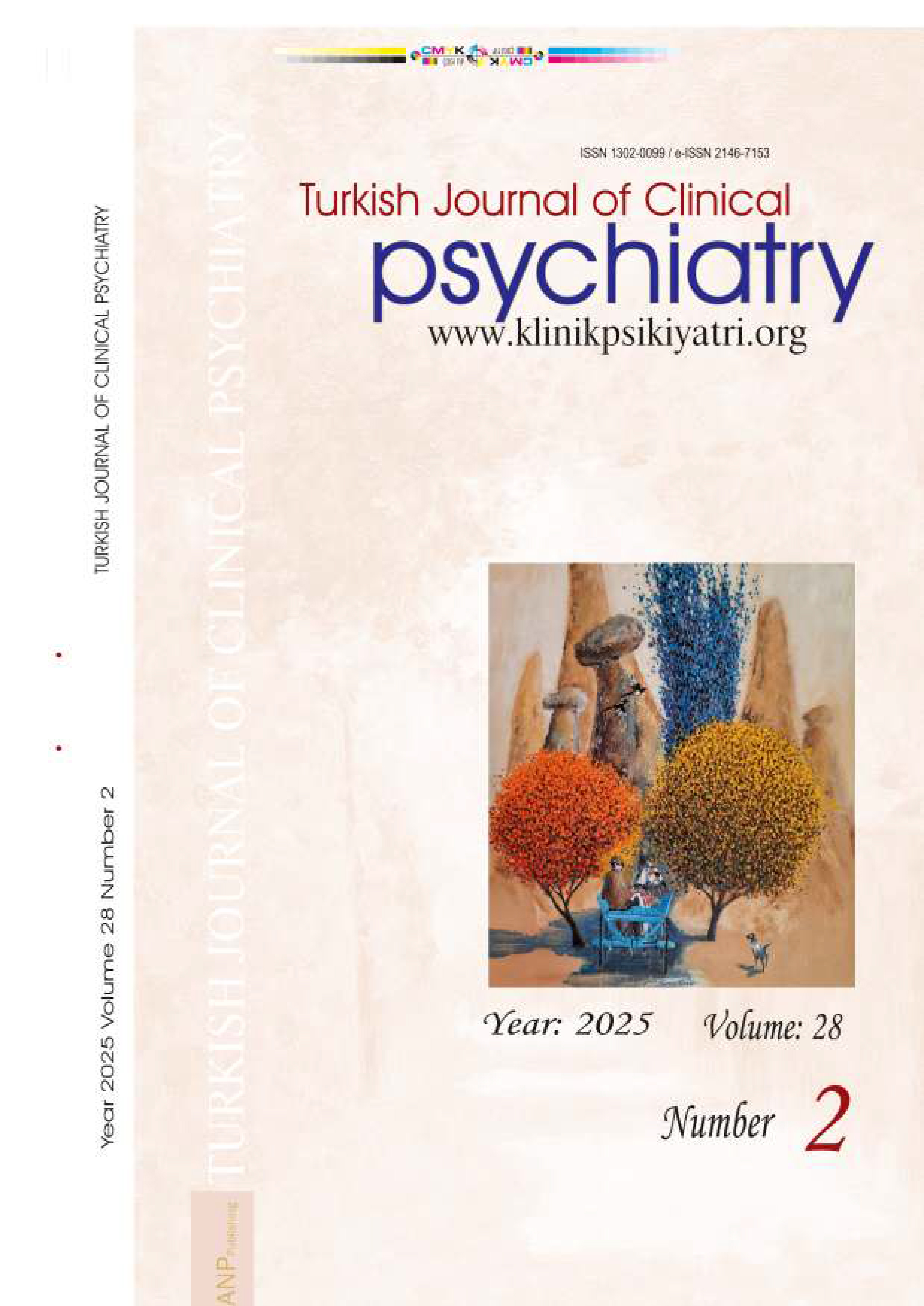





Volume: 14 Issue: 4 - 2011
| RESEARCH ARTICLE | |
| 1. | Validity and Reliability of the Turkish Version of the Personality Belief Questionnaire- Short Form (PBQ-STF) in the University Students İbrahim Taymur, M. Hakan Türkçapar, Sibel Örsel Pages 199 - 209 Objectives: The aim of this study is to study the validity, reliability and the psychometric properties of the Turkish version of the Personality Belief Questionnaire- Short Turkish form (PBQ-STF). Method: PBQ-STF is applied to 232 university students. Dysfunctional Attitudes Scale (DAS) and Temperament and Character Inventory (TCI) are also applied to the group in order to test the validity related to the measure of value. Results: The Cronbach alpha value is found 0.923 for the whole 65 item scale (p<0.05). Cronbach alpha scores found between 0.61- 0.85 for the whole subscales. The dependent and the histrionic subscales were the most affected ones when the short form was used instead of the long Turkish form. The reliability values observed were high except for the avoidant, dependent and the histrionic subscales. After the factor analysis, two factors were obtained which were able to explain 58.1% of the total variance. Also passive-aggressive, obsessive-compulsive, antisocial, narcissistic, histrionic, schizoid and paranoid dimensions took place in factor 1, and dependent and avoidant dimensions took place in factor 2 similar to the validity and reliability study of the Turkish version and the original version of the PBQ. All the subscales of the PBQ-STF were significantly correlated with the perfectionism subscale of the DAS. There were also significant correlations between the subscales of TCI and the subscales of the PBQ-STF. Conclusion: These findings about PBQ-STF prove that the scale is a reliable and an easy to apply instrument to determine the beliefs about the personality. |
| 2. | The Frequency of Psychiatric Diagnosis in Obese Women Osman Özdel, Gülfizar Sözeri Varma, Semin Fenkçi, Taner Değirmenci, Filiz Karadağ, Nalan Kalkan Oğuzhanoğlu,, Figen Ateşçi Pages 210 - 217 Objectives: The aim of the present study was to investigate frequency of psychiatric disorders and severity of depression in obese women. Method: The sample was consisted of 55 obese women consecutively admitted to the endocrinology outpatient clinic, Body Mass Index (BMI) 30 and over and without chronic physical disease. Control group was formed of 55 women that same age group, BMI 25 and under and without chronic physical disease. Structured psychiatric interview (SCID-I) according to the DSM-IV diagnostic criteria were performed all individuals participating in the study. The severity of depression were assessed by the Hamilton Rating of Depression Scale (HAM-D17). Results: It was determined that mean age 41.07±10.00 years in obese group, 43.38± 7.38 years in control group. There was no difference between the two groups. BMI was higher in obese women than the control group (respectively 37.38±6.75, 22.26±1.91). The prevalence of psychiatric disorders was higher in the obese subjects than the control group (respectively 60% n=33, 9.1% n = 5). Mood disorders and anxiety disorders were the most found diagnosed in obese group in present and lifetime. HAM- 017 scores of obese subjects were significantly higher than the control group. Conclusion: In our study, women who seek treatment for obesity, the prevalence of psychiatric disorders are higher than normal-weight women. Our results support the existence of the relationship between obesity and psychopathology. Psychiatric evaluation is necessary obese women who seek treatment for obesity. |
| 3. | Evaluation of Sociodemographic Characteristics, Parental Attitude and Anger Expression Among Female Offenders Huriye Ersen, M. Cem İInem, Nedim Havle, Ferhan Yener, Nesrin Karamustafalıoğlu, Derya İpekçioğlu Pages 218 - 229 Objectives: It is suggested that anger, violence and parent's attitude have a relation with crime. Mostly, demographic features, sociocultural and economic factors that lead women for the criminal act are emphasized in a few studies about women criminality. Due to the lack of data about female delinquency in psychiatric practice, we aimed to investigate socio-demographic characteristics, parental attitude and anger expression manners among female offenders. Method: Of the 176 incarcerated women in Istanbul Bakirkoy Women Jail, 102 women were participated in the study. Control group was composed of 77 healthy women who had never a prison life. All individuals were informed about the study and "data form", "multidimensional anger inventory" and "parental attitude scale" were applied for whom accepted to participate. Results: The educational and income levels were lower in female offenders. Divorced and married women were obtained to have higher crime rate. Alcohol and substance abuse rates were significantly higher in incarcerated women. In anger inventory, significant difference was obtained in all the parameters except "factors that cause anger". Authoritarian family structure has drawn attention in parental attitude scale in both of the groups. Conclusion: Anger and anger control are ignored in incarcerated women due to low frequency of crime in women; this matter should be one of the aim of rehabilitation in women jail. |
| 4. | Relationship Between Job Satisfaction and Stress The Employee of Health Personnel in Public Hospitals Derya Nur Pages 230 - 240 Objectives: The aim of this research is to study related stress and job satisfaction of health service personel in public hospitals, and to explore in terms of demographic characteristics. Method: This study has been executed over 412 person. The sample people group which consists of specialist doctors, practitioner doctors, nurses/midwifes, technicians and other medical health personnels who are chosen by random sampling and who are working at there different public hospitals at one city. For data collecting, Socio-demographic information form, Job Satisfaction Scale, Stress Symptoms Scale and Tendency to Stress Scale has been used and for data analyzing one and two directional varians analysis (ANOVA), Post Hoc-Tukey test, t-test, Mann-Whitney U test, Pearson and Spearman tests, and multi regression analysis has been applied. Results: According to the correlation analysis, there is a strong negative association between stress and job satisfaction. According to t-test and varians analysis; women stuff are more stressful than men stuff, men stuff are very satisfied in their jobs, the age and the period of working in the departmant is correlated with job satisfaction, the nurses are more stressful than others, it is emphasized that the stuff of Emergency, Cardiology, Otorhinolaryngology, Neurosurgery, Orthopedy and Operating room are more stressful than the others. According to regression analysis, first three predictor of job satisfaction are administrative policy, salary/career and control/autonomy in order. Conclusion: Stres and job satisfaction must be assessed together in health professions. The findings are consistent with the literatüre. |
| REVIEW | |
| 5. | Diagnosis and Treatment of Premenstrual Syndrome and Premenstrual Dysphoric Disorder: A Review A. Figen Türkçapar, Hakan Türkçapar Pages 241 - 253 Premenstrual syndrome (PMS) is a condition which appear at the late luteal phase of menstrual cycles with physical changes include breast swelling, fatigue, headache, weight gain and psychological changes include depressive mood, irritability, and tension. These changes remit after the onset of menstruation. This syndrome can occur 80% of women population but it is severe form can only be seen 5% of women and called premenstrual dysphoric disorder or late luteal phase syndrome. In this review, current literature about diagnosis, etiology and treatment of premenstrual syndrome and premenstrual dysphoric disorder is examined. We searched Pubmed Medline (1950-2011 jusing the terms "premenstrual syndrome," "premenstrual dysphoric syndrome,". The exact cause of PMS has not been identified, but several theories were proposed to explain this disorder. Biological etiology of the disorder explained by the sensitivity of some women's to normal biological fluctuations of gonadal hormones. Psychosocial factors also influence the severity of symptoms. These biological and psychological vulnerability presented as somatic and psychological symptoms of the premenstrual dysphoric disorder. Current evidences suggested that this disorders stem from the interaction between hormones and the central nervous system and pharmacological agents and psychosocial interventions can alleviate the symptoms of this disorder. For many women with mild symptoms, lifestyle approaches are enough to control symptoms. In severe cases, hormonal treatments and antidepressants may be helpful. Combined oral contraceptive drugs and selective serotonin-reuptake inhibitors are used to treat premenstrual symptoms. Cognitive behavioral therapy may be an alternative psychosocial treatment to drug treatments. |










